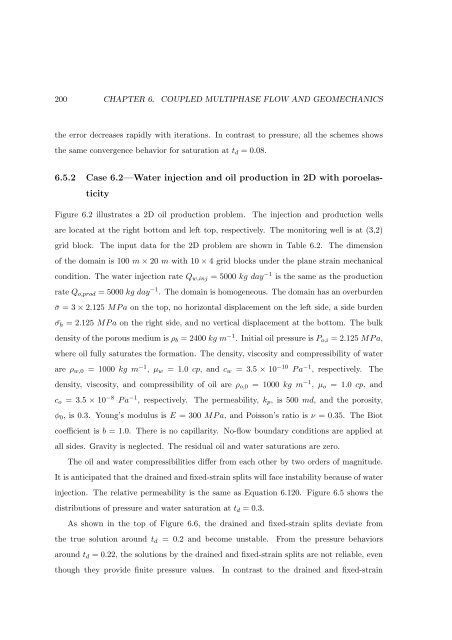Sequential Methods for Coupled Geomechanics and Multiphase Flow
Sequential Methods for Coupled Geomechanics and Multiphase Flow
Sequential Methods for Coupled Geomechanics and Multiphase Flow
Create successful ePaper yourself
Turn your PDF publications into a flip-book with our unique Google optimized e-Paper software.
200 CHAPTER 6. COUPLED MULTIPHASE FLOW AND GEOMECHANICS<br />
the error decreases rapidly with iterations. In contrast to pressure, all the schemes shows<br />
the same convergence behavior <strong>for</strong> saturation at td = 0.08.<br />
6.5.2 Case 6.2—Water injection <strong>and</strong> oil production in 2D with poroelas-<br />
ticity<br />
Figure 6.2 illustrates a 2D oil production problem. The injection <strong>and</strong> production wells<br />
are located at the right bottom <strong>and</strong> left top, respectively. The monitoring well is at (3,2)<br />
grid block. The input data <strong>for</strong> the 2D problem are shown in Table 6.2. The dimension<br />
of the domain is 100 m × 20 m with 10 × 4 grid blocks under the plane strain mechanical<br />
condition. The water injection rate Qw,inj = 5000 kg day −1 is the same as the production<br />
rate Qo,prod = 5000 kg day −1 . The domain is homogeneous. The domain has an overburden<br />
¯σ = 3 × 2.125 MPa on the top, no horizontal displacement on the left side, a side burden<br />
¯σh = 2.125 MPa on the right side, <strong>and</strong> no vertical displacement at the bottom. The bulk<br />
density of the porous medium is ρb = 2400 kg m −1 . Initial oil pressure is Po,i = 2.125 MPa,<br />
where oil fully saturates the <strong>for</strong>mation. The density, viscosity <strong>and</strong> compressibility of water<br />
are ρw,0 = 1000 kg m −1 , µw = 1.0 cp, <strong>and</strong> cw = 3.5 × 10 −10 Pa −1 , respectively. The<br />
density, viscosity, <strong>and</strong> compressibility of oil are ρo,0 = 1000 kg m −1 , µo = 1.0 cp, <strong>and</strong><br />
co = 3.5 × 10 −8 Pa −1 , respectively. The permeability, kp, is 500 md, <strong>and</strong> the porosity,<br />
φ0, is 0.3. Young’s modulus is E = 300 MPa, <strong>and</strong> Poisson’s ratio is ν = 0.35. The Biot<br />
coefficient is b = 1.0. There is no capillarity. No-flow boundary conditions are applied at<br />
all sides. Gravity is neglected. The residual oil <strong>and</strong> water saturations are zero.<br />
The oil <strong>and</strong> water compressibilities differ from each other by two orders of magnitude.<br />
It is anticipated that the drained <strong>and</strong> fixed-strain splits will face instability because of water<br />
injection. The relative permeability is the same as Equation 6.120. Figure 6.5 shows the<br />
distributions of pressure <strong>and</strong> water saturation at td = 0.3.<br />
As shown in the top of Figure 6.6, the drained <strong>and</strong> fixed-strain splits deviate from<br />
the true solution around td = 0.2 <strong>and</strong> become unstable. From the pressure behaviors<br />
around td = 0.22, the solutions by the drained <strong>and</strong> fixed-strain splits are not reliable, even<br />
though they provide finite pressure values. In contrast to the drained <strong>and</strong> fixed-strain
















